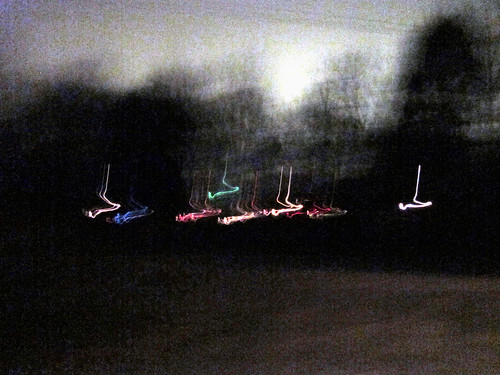I had the pleasure of meeting my beautiful wife for lunch this afternoon and, although it was a dreary day, I brought my new camera downtown and took a few photos. I'm glad I did. I had never before noticed this piece of urban street art, painted on a boarded up window of an abandoned building on Commerce Street--but, today, the drawing's disarming simplicity and vibrant colors immediately caught my eye. I was stopped in my tracks! Perhaps it was the weather or the post-holiday blues--whatever--I was touched by the enigmatic, childish glee so vividly expressed in this piece. Thank you to the anonymous artists for ennobling this derelict structure and brightening a grey winter day.
December 29, 2010
December 26, 2010
December 25, 2010
Playlist Week of 12-25-10
 * J.S. Bach: Mass In B Minor (Collegium Vocale Gent/Herreweghe) (Harmonia Mundi 2CD)
* J.S. Bach: Mass In B Minor (Collegium Vocale Gent/Herreweghe) (Harmonia Mundi 2CD)* Vivaldi: Cello Sonatas (ter Linden/Mortensen) (Brilliant Classics 2CD)
* Handel: Organ Concertos, Op.7 (Academy of Ancient Music/Egarr) (Harmonia Mundi 2SACD)
* Handel: Trio Sonatas Op.2&5 (Academy of Ancient Music/Egarr) (Harmonia Mundi 2CD)†
* Boulez: Le Marteau sans Maître/Dérive 1&2 (Ens. Intercontemporain/Summers/Boulez)(DG CD)
* The Boston Pops (Fiedler): Pops Christmas Party (RCA CD)
* John Coltrane: Ascension (Impulse! CD)
* John Coltrane/Archie Shepp: New Thing At Newport (Impulse! CD)
* John Coltrane: Sun Ship (Impulse! CD)
* John Coltrane: First Meditations (Impulse! CD)
* John Coltrane: Live In Seattle (Impulse! 2CD)
* Bill Evans: Complete Village Vanguard Recordings, 1961 (d.1&3) (Riverside 3CD) †
* Sun Ra & His Space Arkestra: What Planet Is This? (Leo 2CD)
* Henry Threadgill’s Zooid: This Brings Us To, Vol. I (Pi CD)
* Henry Threadgill’s Zooid: This Brings Us To, Vol. II (Pi CD)
* Myra Melford’s Be Bread: The Image of Your Body (Cryptogramophone CD)
* Mary Halvorson: Saturn Sings (Firehouse 12 CD)
* The Free Zen Society: The Free Zen Society (Thirsty Ear CD)
* DJ Wally: Nothing Stays the Same (Thirsty Ear CD)
* Nina Simone: Anthology (d.1) (RCA/BMG Heritage 2CD)
* Elvis Presley: If Every Day Was Like Christmas (RCA CD)
* Emmylou Harris: Light of the Stable: The Christmas Album (Warner Bros. CD)
* The Beatles: I Hope We Passed The Audition (Purple Chick/fan/boot CDR)
* The Beatles: Please Please Me (2009 stereo) (Apple/EMI CD)
* The Beatles: With The Beatles (2009 stereo) (Apple/EMI CD)
* The Beatles: A Hard Day’s Night (2009 stereo) (Apple/EMI CD)
* The Beatles: Beatles For Sale (2009 stereo) (Apple/EMI CD)
* The Beatles: Help! (1987/2009 stereo) (Apple/EMI CD)
* The Beatles: From Then To You (The Christmas Record) (Purple Chick/fan/boot CDR)
* Van Morrison: A Sense of Wonder (Mercury CD)
* Grateful Dead: Univ. of Illinois, Chapaign-Urbana 2-22-73 (d.2) (SBD 2CDR)
* Grateful Dead: Nassau Coliseum, Uniondale, Long Island, NY 3-31-93 (SBD 2CDR)‡
* Grateful Dead: Nassau Coliseum, Uniondale, Long Island, NY 4-02-93 (SBD 2CDR) ‡
* Bob Dylan: Infidels (Columbia SACD)
* Bob Dylan: Christmas In the Heart (Columbia CD)
* Bob Dylan’s Theme Time Radio Hour No.34: “Christmas & New Year’s” (FM 2CDR)
* V/A: Elton John’s Christmas Party (selections) (Hear Music CD)
* V/A: Viper vs. Gingerman (mix CDR)
* Yes: Relayer (Atlantic/Rhino CD)
* Yes: Going For The One (Atlantic/Rhino CD)
* Sonic Youth w/Tim Barnes: Koncertas Stan Brakhage Prisiminimui (SYR-6 CD)
* Sonic Youth: “J’Accuse Ted Hughes”/“Agnes B. Musique” (SYR-7 LP)
* Guided By Voices: Live in Daytron ?6° (Rockathon 3LP/FLAC)
* Radiohead: Kid A (Capitol CD)
* Radiohead: Amnesiac (Capitol CD)
* Radiohead: “Knives Out” (EMI—UK CDEP)
* Radiohead: “Pyramid Song” (EMI—Japan CDEP)
†=iPod
‡=car
Commentary:
Christmastime presents both opportunities and challenges for the music fan. There is, of course, a rich tradition of both sacred and secular music devoted to the season, but the omnipresence of canned cheer this time of year can become extremely cloying by the time December 25 rolls around. Even so, there are plenty of great records which will always get me in the yuletide spirit.
So I was initially skeptical when Bob Dylan released Christmas In The Heart last year. Don’t get me wrong, I love the guy, but the idea of latter-day Bob croaking and growling his way through “O Little Town of Bethlehem” seemed particularly unappetizing—even to me. But I kept hearing good things about the album from people whose opinions I respect, so I recently added it to my modest collection of Christmas CDs. It’s actually pretty great!
The first thing you notice is Dylan’s guileless sincerity—he sings like a true believer and his road-weary vocals bring a genuine poignancy to hoary old carols like “Do You Hear What I Hear?” and “O Come All Ye Faithful” and his gravelly performances of sentimental favorites like “I’ll Be Home for Christmas” and “Have Yourself a Merry Little Christmas” possess a magnificent pathos. Well, OK; doubters will likely not be convinced of Dylan’s vocal abilities, but admirers will be duly impressed. His long-standing touring band (augmented by chirpy backup vocalists) demonstrates their chameleonic ability to inhabit the myriad styles of music while maintaining a singular, first-take professionalism. And it sounds like everyone is having fun, especially Bob, whose takes on “Here Comes Santa Claus” and “Must Be Santa” are so joyful as to make even a jaded Dylan fan laugh out loud.
Lizzy pointed out that the whole packaging and production harks back to the kinds of cheesy seasonal LPs you might find in your parents’ (or grandparents’) record collections, the kind given away at a full-service gas stations back in the early-‘Sixties. That is no doubt part of Christmas In The Heart’s peculiar charm, a familiar, timeless ambience which perfectly captures the comforting, nostalgic spirit of the season. Plus, all proceeds go to Feeding America. Good stuff!
Check out this video for “Must Be Santa” and see/hear for yourself—it’s hilarious! I hope everyone has had a joyous day! Merry Christmas and Happy Krimble to everybody out there in the blogosphere!
I'm Dreaming of a White Christmas
It snowed enough to make it pretty, but not so much as to cause problems. Perfect!
December 24, 2010
It's Christmas Eve...
They're predicting some snow overnight, which would make for the first white Christmas in Nashville in seventeen years--and the first for us since we moved here. We have a fire in the fireplace and some swingin' seaonal tunes on the stereo. All of us here at chez NuVoid wish you all a very merry Christmas!
December 21, 2010
Happy Solstice!
Finally, the days will start to lengthen. Sounds like a reason to celebrate! Wish I could have seen the lunar eclipse, but it was too cloudy. I hope everyone has a safe, happy, and warm winter!
December 19, 2010
Sun Ra Sunday
 THE ROSE WILL BLOOM
THE ROSE WILL BLOOMThe rose will bloom
The broken bowl
Will never know
The perfect self
It once was shaped.
And though the heavens
Are as far from man
As all the past,
They are not lifeless
Or insensitive
As one would think . . . . . . .
Seeing they are so distant;
Even as the past knows all the ways
Knows all the ways of man,
So the vast
And
Timeless firmament knows:
And being what is,
It bides that we should search
For celestial-cosmo-truth of myth;
That we should know at last
Our true worth and insignificance
In proximity to the
Endless-Eternal Myth . . . . . . . . .
--Sun Ra
December 18, 2010
Playlist Week of 12-18-10
 * Palestrina, et al.: Die Kleinorgel (de Klerk) (Telefunken LP)
* Palestrina, et al.: Die Kleinorgel (de Klerk) (Telefunken LP)* Buxtehude: Six Sonatas (Holloway/Mortensen/ter Linden) (Naxos CD)
* Biber: Mensa Sonora (Musica Antique Köln/Goebel) (Archiv Produktion CD)†
* Biber: Harmonia Artificioso (Musica Antique Köln/Goebel) (Archiv Produktion CD)†
* Handel: Organ Concertos, Op.4 (Academy of Ancient Music/Egarr) (Harmonia Mundi SACD)
* Mendelssohn: Songs Without Words (Rév) (Hyperion 2CD)
* Gershwin: Rhapsody In Blue, etc. (Boston Pops/Fiedler/Wild) (RCA SACD)
* Lachenmann: Schwankungen am Rand (Ensemble Modern/Eötvös) (ECM CD)
* John Coltrane: One Down, One Up: Live at the Half Note (Impulse! 2CD)
* John Coltrane: John Coltrane Quartet Plays (Impulse! CD)
* John Coltrane: Living Space (Impulse! CD)
* John Coltrane: Transition (Impulse! CD)
* Tony Williams: Life Time (Blue Note CD)
* Andrew Hill: Andrew!! (Blue Note CD)
* Andrew Hill: Compulsion (Blue Note CD)
* Andrew Hill: Change (Blue Note CD)
* Sun Ra: The Singles (d.2) (selections) (Evidence 2CD)
* Sun Ra: What Planet Is This? (Leo 2CD)
* Anthony Braxton/Walter Thompson Orchestra: Irondale Center, Brooklyn, NY 4-16-09 (AUD 2CDR)
* Aretha Franklin: Lady Soul/Aretha Now (Atlantic/Mobile Fidelity CD)
* Grateful Dead: Assembly Hall, Univ. of Illinois, Champaign-Urbana 2-21-73 (SBD 3CDR)
* Grateful Dead: Assembly Hall, Univ. of Illinois, Champaign-Urbana 1-22-73 (d.1) (SBD 2CDR)
* Grateful Dead: Knickerbocker Arena, Albany, NY 3-27-93 (SBD 3CDR) ‡
* Grateful Dead: Knickerbocker Arena, Albany, NY 3-28-93 (SBD 3CDR) ‡
* Grateful Dead: Knickerbocker Arena, Albany, NY 3-29-93 (selections) (SBD 3CDR) ‡
* Van Morrison: Poetic Champions Compose (Polydor CD)
* Van Morrison: No Guru, No Method, No Teacher (Polydor CD)
* Chicago: VII (Columbia 2LP)
* Frank Zappa: Studio Tan (DiscReet LP)
* Frank Zappa: Orchestral Favorites (DiscReet LP)
* Frank Zappa: Sleep Dirt (DiscReet LP)
* Frank Zappa: Zappa In New York (Rkyo 2CD)
* Captain Beefheart: Trout Mask Replica (Reprise CD)
* Yes: Tormato (Atlantic/Rhino CD)
* Phil Collins: Face Value (Atlantic/Audio Fidelity CD)
* The Fall: This Nation’s Saving Grace (Beggar’s Banquet—UK CD)
* The Fall: Bend Sinister (Beggar’s Banquet—UK CD)
* The Fall: The Frenz Experiment (Beggar’s Banquet/RCA CD)
* Sonic Youth: Goodbye Twentieth Century (SYR-4 2LP)
* Kim Gordon/DJ Olive/Ikue Mori: SYR-5 (SYR-5 2EP)
†=iPod
‡=car
Commentary:
What a week! Even though we’re days away from the Solstice, winter weather moved in on Sunday with six inches of snow, and topped it off with freezing rain on Wednesday. Fortunately, it warmed up overnight and regular wet rain on Thursday melted everything. Sheesh! Is this what it’s going to be like? Today is the first time we’ve seen the sun all week. Well, one nice thing about a “snow day” is getting time to listen to more records!
+++
I’m a huge fan of John Coltrane, but, for me, the music he made in 1965 is by far the most astonishing. He was incredibly prolific during this period, as if he could barely keep up with the flood of ideas—as if he knew he only had another couple of years left—and you can hear his rapid development from the relatively straightforward modalism of John Coltrane Quartet Plays through the experimental chamber jazz found on Living Space and Transition, leading directly to the cathartic spiritualism of Sun Ship, Ascension and Meditations later in the year. In the process, the so-called “classic quartet” disintegrated, as first Elvin Jones, and then McCoy Tyner quit the band, unwilling to go as far as Coltrane needed to go (or maybe they were just unwilling to share the stage with newcomers Pharoah Sanders and Rashied Ali). By November, the tension is audible. Nevertheless, the almost overwhelming intensity of the music is part of what makes these last records of 1965 the summit of Coltrane’s achievement and I’m looking forward to listening them this coming week.
+++
Debate rages amongst Zappaphiles regarding Frank’s true intentions regarding Läther (pronounced “leather”), a proposed four-LP box set of high-gloss rock-jazz and ambitious orchestral music recorded in 1974-1976. As the story goes, test pressings were made but Warner Bros. apparently refused to release it. But I suspect the mythical Läther was just a ploy to break his contract with the label. Zappa was in the midst of myriad disputes with his manager and Warner Bros. during this period, and, in December, 1977, he played an entire eight-sided test pressing over KRQQ radio station in Pasedena, encouraging listeners to tape it off the air, which, of course, many of them did. This tactic evidently worked: by 1978, Zappa had extricated himself from the contract with Warner Bros.—but the Läther material began to appear on the now defunct DiscReet label on four separate albums, Zappa In New York, Studio Tan, Orchestral Favorites and Sleep Dirt (the latter three with lurid artwork by Gary Panter and zero credits). Regardless of their provenance, these are some of my favorite Zappa records.
As usual, the music ranges from brilliantly sophisticated instrumentals to the most puerile songs imaginable. The twenty-minute “Greggery Peccary” (Studio Tan) manages to combine it all into a metaphorical fable about the invention of the calendar—probably one of Zappa’s most successful musical satires ever. Orchestral Favorites is just what it says, Frank’s demanding “classical” scores—sometimes augmented by his rock band. Good stuff. Sleep Dirt is another all-instrumental album but with a more jazz-rock-fusion feel—except for the title track, an acoustic guitar duet with James Youman, which exhibits Frank’s rarely-heard soft and sensitive side. Zappa In New York compiles live recordings from The Palladium in December, 1976 and while the jokey material has worn thin for me (e.g. “Titties and Beer”; "The Illinois Enema Bandit”), the musicianship is uniformly spectacular. The Ryko CD restores the censored “Punky’s Whips” (another bit of homophobic (?) theatricality) along with four other unreleased tracks from these shows, but the digital mastering leaves a lot to be desired. The sound quality of the original LPs is fantastic: warm and detailed, with a vast, welcoming soundstage. Further, the official Läther three-CD set released by Ryko in 1996 includes dubious editing and overdubs that lessen the impact of many of these tracks. Whatever Frank’s true intentions, I prefer the individual albums in their original presentation. Your mileage may vary.
December 17, 2010
R.I.P. Don Van Vliet (a//k/a Captain Beefheart)
 Don Van Vliet, also known as Captain Beefheart, died today at the age of 69 from complications from multiple sclerosis. Popularly known as a musician/poet/auteur whose 1969 album, Trout Mask Replica (produced by Frank Zappa) is a masterpiece of avant-rock, he later abandoned music only to find financial success as a painter, represented by the prestigious Michael Werner Gallery in New York. MS is an insidious disease and 69 is too young for such talent to die. RIP, Mr. Van Vliet.
Don Van Vliet, also known as Captain Beefheart, died today at the age of 69 from complications from multiple sclerosis. Popularly known as a musician/poet/auteur whose 1969 album, Trout Mask Replica (produced by Frank Zappa) is a masterpiece of avant-rock, he later abandoned music only to find financial success as a painter, represented by the prestigious Michael Werner Gallery in New York. MS is an insidious disease and 69 is too young for such talent to die. RIP, Mr. Van Vliet.
December 13, 2010
Ice and Snow
This weather is starting to feel a lot more like New England than Tennessee. Pretty to look at; not so much fun to drive in.
December 12, 2010
Sun Ra Sunday
 Sun Ra: The Singles (Evidence 2CD)
Sun Ra: The Singles (Evidence 2CD)In 1974, at the height of the Impulse! deal, the resurrected Saturn label released two seven-inch 45-RPM singles, in an effort, perhaps, to capitalize on the major label’s support and media exposure. Crudely manufactured in small batches, they were sold from the bandstand or to certain favored record stores for cash on the barrelhead, making them extremely rare and highly-prized collector’s items today. Thankfully, the Evidence label has collected all the known Saturn singles onto two CDs, making these weird and wonderful sides available to all. As usual, the discographical details are sketchy, but we can rely on Prof. Campbell’s research and speculations to fit them into the chronology.
“I’m Gonna Unmask the Batman”/”The Perfect Man” (Saturn ES 537)
Continuing Sun Ra’s odd infatuation with Batman and Robin the A-side is a remake of the Lacy Gibson/Alton Abraham ditty first recorded for Repeto in 1968 (without Sun Ra’s involvement). This version “I’m Gonna Unmask the Batman” was probably taken from a live broadcast at WXPN-FM in Philadelphia on July 4, 1974 under the auspices of Hal Wilner (see, Campbell & Trent pp.209-210). The vocalist is Sam Bankhead (who appeared in the Space is the Place movie) and there’s a small complement of riffing horns while Sonny provides the bass-line on his reedy RMI Rocksichord. Despite the silliness of the tune, Sun Ra would return to it again and again in concert, making this, I suppose, the definitive version.
The flip side is something else altogether: In his liner notes to The Singles collection, Prof. Campbell suggests that “The Perfect Man” may be Sun Ra’s “most perfectly realized synthesizer performance.” A particularly captivating space-rock-boogaloo driven by Sonny’s boing-ing MiniMoogs, the head is tightly arranged for the tangy ensemble of Marshall Allen’s oboe and John Gilmore’s tenor sax. Probably recorded at Variety in May 24, 1973, the “Micro-Ensemble Unit” actually sounds surprisingly well rehearsed and polished on this almost-pop-worthy confection (despite the amateurish drumming of Danny Davis). Very interesting.
“Journey to Saturn”/”Enlightenment” (Saturn ES 538)
Saturn ES 538 focuses on two of the common space-chants from the repertoire. “Journey to Saturn“ is taken from an unknown live performance circa. 1972-74, as indicated by the unbalanced and overamplified sound. Clifford Jarvis swings hard on drums and Gilmore and June Tyson duet while Sonny churns out some gritty organ accompaniment. After a bluesy solo from Ra that veers off into distant keys, Tyson returns briefly a cappella. The B-side is yet another remake of “Enlightenment,” a song that obviously meant a lot to Ra. Recorded at the House of Ra in Philadelphia sometime between 1970 and 1974, this stripped down version is really quite affecting. The tempo is slow and deliberate, held together by Gilmore’s remarkably supple drumming and Sonny’s orchestral clavinet playing. Gilmore and Tyson sing with full-throated sincerity and, even though Gilmore drops his sticks at one point, he never loses a beat. The lo-fi, homemade quality of the recording only adds to the charm—this one has that inimitable “Saturn Sound.” A nice rendition of this sometimes overplayed song.
December 11, 2010
Playlist Week of 12-11-10
 * J.S. Bach: Goldberg Variations/Canons (Egarr) (Harmonia Mundi 2CD)†
* J.S. Bach: Goldberg Variations/Canons (Egarr) (Harmonia Mundi 2CD)†* J.S. Bach: Suites for Violoncello (ter Linden) (Harmonia Mundi 2CD)†
* J.S. Bach: Violin Sonatas (Manze/Egarr/ter Linden) (Harmonia Mundi 2CD)
* Thelonious Monk: The Complete Blue Note Recordings (d.4) (Blue Note 4CD)
* Thelonious Monk Quartet with John Coltrane: At Carnegie Hall (Blue Note CD)
* Thelonious Monk & John Coltrane: The Complete 1957 Riverside Recordings (Riverside 2CD)
* Eric Dolphy Quintet: Outward Bound (New Jazz/OJC CD)
* Eric Dolphy: Out There (Prestige/OJC CD)
* Eric Dolphy: At the Five Spot Vol.1 (Prestige/OJC—Japan CD)
* Eric Dolphy: At the Five Spot Vol.2 (Prestige/OJC—Japan CD)
* Herbie Hancock: Takin’ Off (Blue Note CD)
* Grant Green: Idle Moments (Blue Note CD)†/‡
* Sun Ra: What Planet Is This? (Leo 2CD)
* Sun Ra: The Singles (d.2) (selections) (Evidence 2CD)
* Anthony Braxton Large Ensemble: Wesleyan University, Middletown, CT 12-03-08 (AUD CDR)
* V/A: The Oxford American Southern Music CD No.12 (Alabama) (Oxford American Magazine CD)
* Aretha Franklin: I Never Loved a Man The Way I Love You (Atlantic/Mobile Fidelity CD)
* Grateful Dead: The Spectrum, Philadelphia, PA 8-30-80 (d.2-3) (SBD 3CDR) †/‡
* Grateful Dead: Kaiser Convention Center, Oakland, CA 11-21-85 (SBD 3CDR)
* Big Star: Keep An Eye On the Sky (d.3) (Ardent/Rhino 4CD) †/‡
* The Clash: London Calling (CBS—UK 2LP)
* The Clash: Sandinista! (Epic 3LP)
* The Fall: Hex Enduction Hour (Kamera/Line CD)
* The Fall: Perverted By Language (Rough Trade/Line CD)
* The Fall: The Wonderful and Frightening World of…The Fall (Beggar’s Banquet—UK CD)
* U2: The Unforgettable Fire (Deluxe Edition) (d.1) (Island/Universal 2CD) †/‡
* Sonic Youth: “Anagrama” (SYR-1 EP)
* Sonic Youth: “Slaapkamers Met Slagroom” (SYR-2 EP)
* Sonic Youth/Jim O’Rourke: “Invito Al Ĉielo” (SYR-3 LP)
* Sonic Youth: A Thousand Leaves (Geffen 2LP)
* Robert Pollard: Off to Business (GBV, Inc. LP)
* Robert Pollard: “Weatherman and Skin Goddess” (side B) (GBV, Inc. EP)
* Robert Pollard: Moses On A Snail (GBV, Inc. LP)
* Animal Collective: Merriweather Post Pavilion (Domino CD) †/‡
* Animal Collective: Fall Be Kind (Domino CDEP) †/‡
†=iPod
‡=car
Commentary:
The Oxford American Southern Music Issue arrived in the mailbox this week and, as usual, it’s a feast for the eyes and ears. We’re long-time subscribers and The Oxford American has always lived up to its subtitle, “The Southern Magazine of Good Writing”; it’s always worth reading. But, most of all, we look forward to the annual Southern Music Issue, where the magazine serves as a set of elaborate liner notes for the accompanying compact disc, an always generous selection of fascinating tracks, famous and obscure, old and new. Of course, you don’t have to be a Southerner to appreciate this stuff—all you need is a beating heart—the perceptive writing and sharp graphics will fill you in on everything else you might need to know. This year, the focus is on the music of Alabama (as last year’s was devoted to Arkansas). I’ve barely delved into it, but it’s the usual friendly collision of styles and genres, from hillbilly country blues to New Wave; jump-jazz to R&B soul to hip-hop and beyond—and the respective essays are illuminating and, sometimes, quite touching. The whole thing is obviously a labor of love and well worth the eleven-dollar cover price—if you can find one on the newsstand. Subscriptions are only twenty bucks and ensure that you won’t miss out on all the fun. Would make a great gift! Most highly recommended!
My New Toy!
I’ve wanted a “point-and-shoot” camera for a while now. Back when I got my digital SLR (which I love—don’t get me wrong!), I gave the old Coolpix L3 to Lizzy—and darned if she doesn’t get some fantastic shots out of that thing. Frankly, was starting to feel jealous, since the Nikon D40 and its associated lenses are just too big and heavy to cart around all day; I really wanted a camera I could keep in my pocket at all times. So, I did some research and found that the Canon S95 is considered by many to be “the world’s best compact camera”: about the size of a deck of cards, the S95 features a fast (f/2) lens and vibration control for excellent low-light performance as well as full manual/programmable functionality via an ingenious array of dials and knobs. It also shoots HD video—in stereo! Naturally, I became consumed with desire and made my wishes loudly known to the powers that be. Well, Santa Claus came to our house a little early this year, bringing me this fabulous new toy. How exciting! I’m still figuring out how it all works, but, so far, it seems intuitively easy to use and the resulting images are pretty spectacular for such a small camera. I can’t wait to take it with me on my journeys out in the world! Thank you, Santa!
December 5, 2010
Sun Ra Sunday

December 4, 2010
Playlist Week of 12-04-10
 * Monteverdi: Vespro della Beata Vergine (Concentus Musicus Wien/Harnoncourt) (Telefunken 2LP)
* Monteverdi: Vespro della Beata Vergine (Concentus Musicus Wien/Harnoncourt) (Telefunken 2LP)* Buxtehude: Sonatas, Op.1 (Holloway/Mortensen/ter Linden) (Naxos CD)
* J.S. Bach: Brandenburg Concertos (Academy of Ancient Music/Egarr) (Harmonia Mundi 2SACD)
* Count Basie: Basie Big Band (Pablo LP)
* John Coltrane: Live at Birdland (Impulse! CD)
* John Coltrane: Newport ’63 (Impulse!/GRP CD)
* John Coltrane: Crescent (Impulse! CD)
* John Coltrane: A Love Supreme (Impulse! SACD)
* John Coltrane: A Love Supreme (Deluxe Edition) (d.2) (Impulse! 2CD)
* Sun Ra: College Tour Vol.1: The Complete Nothing Is… (ESP-Disk’ 2CD)
* Anthony Braxton Falling River Quartet: Marta-Museum, Herford, Germany 11-22-08 (AUD CDR)
* David S. Ware Quartets: Live in the World (Thirsty Ear 3CD)
* Mat Maneri featuring Joe McPhee: Sustain (Thirsty Ear CD)
* Grateful Dead: Five Seasons Center, Cedar Rapids, IA 7-04-84 (d.1-2) (SBD 3CDR)
* Frank Zappa: Apostrophe (’) (DiscReet LP)
* Frank Zappa/Mothers: Roxy & Elsewhere (DiscReet 2LP)
* Frank Zappa/The Mothers: One Size Fits All (DiscReet LP)
* Frank Zappa/Captain Beefheart/The Mothers: Bongo Fury (DiscReet LP)
* U2: The Unforgettable Fire (Deluxe Edition) (Island 2CD)†/‡
* U2: The Joshua Tree (Deluxe Edition) (Island 2CD)†/‡
* New Order: Power, Corruption and Lies (Deluxe Edition) (d.1)(Factory/Rhino 2CD)†/‡
* The Smiths: The Sound of The Smiths (Sire 2CD)
* Beck: Sea Change (DGC/Mobile Fidelity 2LP)
* Robert Pollard: The Crawling Distance (GBV, Inc. CD)
* Robert Pollard: Moses On a Snail (GBV, Inc. CD)†/‡
†=iPod
‡=car
Commentary:
This past spring, I embarked on a project to listen to all of my Frank Zappa LPs in chronological order and I wrote about my long, complicated relationship with Zappa’s music back in April. But by July, I had to stop and take a break, having reached Over-Nite Sensation (1973), an album I found uproariously funny as a teenager, but now find to be pretty much totally embarrassing. Maybe I just wasn’t in the mood. Well, this past week, I decided to pick up where I left off. I guess I was in a more receptive frame of mind, as I quite enjoyed listening to these albums again after many years. Maybe it’s just the new amplifier that made ‘em sound so good (indeed, these are great sounding records regardless of the musical content).
Apostrophe(‘) (1974) yielded an unlikely hit single with “Don’t Eat the Yellow Snow,” which is really just the introduction to a side-long suite of songs that loosely tell a story about Nanook The Eskimo, parish priest, Father O’Blivion, pancake breakfasts, and the rejection of easy metaphysics. Or something like that. For the most part, Frank keeps the potty humor in check (or at least cloaks it in clever, euphemistic wordplay) and the musicianship is, of course, superb. Side one is quintessential Zappa. The second side is a bit more problematic: it opens strong with a quick ditty (“Excentrifugal Forz”) which seems to pick up where the other side left off, but the following track is a rather pointless jam with Cream bassist, Jack Bruce (“Apostrophe(')”). Then there’s the discomfiting “Uncle Remus.” The music and the sentiments are about as straightforward and sincere as Frank ever got, expressing a lament for the victims of a racist society. And yet the lyrics, with their exaggerated dialect, wrapped up in Zappa’s outrageously salacious voice—well, it will make even (especially?) right-thinking liberals squirm. Which is the point, I guess. “Stink Foot” is as stupid as it sounds and thereby nullifies any big ideas raised in the previous song. Oh well, this is an almost-great record.
On the other hand, Roxy & Elsewhere (1974) has always been one of my favorites, ever since I was a teenage kid with my first hi-fi. Recorded (mostly) live for a never-released film/TV project, this is about as charming and friendly as Frank Zappa ever got. The band is stocked with early-fusion hotshots like George Duke on keyboards, Tom Fowler on bass, Chester Thompson on drums, and the virtuoso percussionist, Ruth Underwood. But it is Tom’s brother, Bruce, who really shines here, both as a soloist and ensemble player, on the otherwise unwieldy trombone. While there is a fair share of comedic nonsense, the music is so compelling, it hardly matters how dumb the subject matter. Zappa is at the height of his powers here. Side two is perfect: opening with a remarkably warm and un-ironic paean to Zappa’s hometown in rural California (“Village of the Sun”). The band then executes a sequence of instrumental pieces which demonstrate Zappa’s command of his quirky, immediately identifiable compositional language, combining a highly chromatic harmonic sensibility with insane rhythmic complexity which culminates in ecstatic releases of rock energy and jazzy soloing (“Echidna’s Arf (Of You)” and “Don’t You Ever Wash That Thing?”). Side three follows up with an endearing send-up of cheesy monster movies (“Cheepnis”) and some pointed political commentary (“Son of Orange County,” about the disgraced Richard Nixon; and “More Trouble Every Day,” a song from Freak Out (1966) about the Watts Riots). Side four concludes with “Be-Bop Tango (Of the Old Jazzmen’s Church)” another ridiculously complicated modern-classical-style composition followed by an equally absurd audience participation segment that goes on for far too long but at least provides us with the classic Zappa quip: “Jazz is not dead; it just smells funny.”
One Size Fits All (1975) is another almost-great album, starting out as it does with “Inca Roads,” probably Zappa’s finest moment. Ostensibly about the crash landing of an alien spaceship, the song begins with an ingratiating yet odd-metered groove and soulful yet quasi-atonal singing by George Duke. Imminently catchy yet severely off-kilter, it draws you in and makes you want to listen, even though it sounds like no other music ever made. Layers of intricately layered instrumental and vocal textures are built up before finally unleashing a towering guitar solo from Frank. Interestingly, the guitar solo is taken from a live recording which is seamlessly spliced into the track. Zappa taped everything and insisted on exact tuning and tempos in live performances, enabling him to utilize a collage approach to musical construction in the studio. The song climaxes with an elaborately asymmetrical coda that doesn’t so much end as segue immediately into the satirical blues, “Can’t Afford No Shoes.” And so it goes with this record: brilliant music, banal lyrics. Thankfully, Frank isn’t going out of his way to be offensive and the songs are wryly humorous, if inconsequential. Ultimately, the rest of the album doesn’t live up to the promise of “Inca Roads,” although that might not be humanly possible, even for Frank Zappa.
Bongo Fury (1975) is a mixed bag, but will be of particular interest to fans of Captain Beefheart (Don Van Vliet), who is featured prominently on this (mostly) live recording. Beefheart’s stories and harangues are amusing, but the band sounds a little unsure of themselves, which is disconcerting given their pedigree. Nevertheless, this album represents an uncharacteristic act of generosity towards Zappa’s childhood friend, whose overt freakiness challenged even his own. (Van Vliet went on to a successful career as a painter.) There are moments that make the experiment worthwhile, but side two is the most satisfying with Frank playing guitar hero on the eleven-minute “Advance Romance” and on the concluding “Muffin Man.” This album gets overlooked by most Zappa-philes, including myself, and while it is somewhat claustrophobic and schizophrenic, there is enough interesting stuff here to warrant multiple listens.
Zappa’s DiscReet label would collapse under the weight of acrimonious lawsuit against his manager, Herb Cohen, and a later dispute with the corporate parent, Warner Bros., over the release of a proposed four-LP box set, to be entitled, Läther. (That material was instead released piecemeal without Zappa’s authorization before the DiscReet label was finally dissolved.) The resulting bitterness is audible in Zappa’s subsequent music, manifesting itself in a palpable contempt for just about everybody, including his listeners. The searing cynicism of his later albums make his mid-‘Seventies works seem lighthearted and sweet by comparison. The Mothers were unceremoniously disbanded and Zappa continued his own way with various musicians who would bend to his iron will—or be sacked. Although there was still interesting music to come, things would never be quite the same.
December 1, 2010
Alex Ross: “Why Do We Hate Modern Classical Music?”

The core problem is, I suspect, neither physiological nor sociological. Rather, modern composers have fallen victim to a long-smouldering indifference that is intimately linked to classical music's idolatrous relationship with the past. Even before 1900, people were attending concerts in the expectation that they would be massaged by the lovely sounds of bygone days. ("New works do not succeed in Leipzig," a critic said of the premiere of Brahms's First Piano Concerto in 1859.)Ross then goes on to show that a handful of orchestras and cultural organizations have found some success—and, perhaps more importantly, younger audiences—with programs featuring such “difficult” modern composers such as, Varése, Xenakis, Stockhausen and Ligeti. Mr. Ross loves the 18th and 19th century "standard repertoire" as much as anyone, but also sees music as a living art, not just polished museum pieces. His tastes range from Mozart to Schoenberg to Sonic Youth and beyond and would like to see "classical" music be treated like all the other arts, like painting, literature, film, and dance. In his view (and mine) music should be a world where anything can happen instead of the same old thing night after night.
The music profession became focused on the manic polishing of a display of masterpieces.
What must fall away is the notion of classical music as a reliable conduit for consoling beauty – a kind of spa treatment for tired souls. Such an attitude undercuts not only 20th-century composers but also the classics it purports to cherish. Imagine Beethoven's rage if he had been told that one day his music would be piped into railway stations to calm commuters and drive away delinquents. Listeners who become accustomed to Berg and Ligeti will find new dimensions in Mozart and Beethoven. So, too, will performers. For too long, we have placed the classical masters in a gilded cage. It is time to let them out.I couldn’t agree more. Go ahead, read the whole thing. It’s brilliant. His new book, Listen to This (FSG), a collection of essays and journalism, is also highly recommended as is his magisterial history of modernism in music, The Rest Is Noise: Listening to the Twentieth Century (FSG, 2007). Reading Alex Ross will make you want to listen to the music he writes about, even if you think you hate it. Give it a try!







